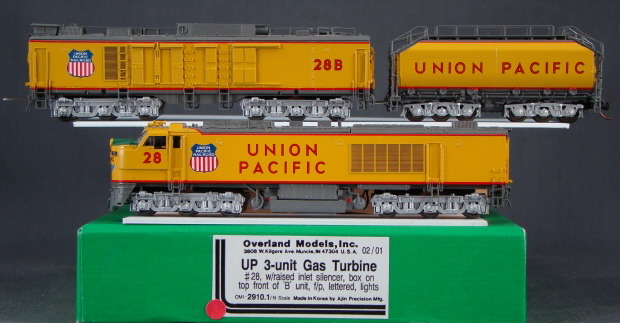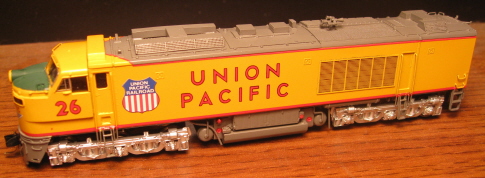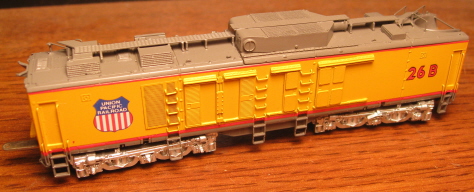

Introduced: 2000
These models are generally sold in three unit sets (powered "A", powered "B" and tender), with the detailing varying from one set to the next (and no, I'm not going to bother with pictures of them all) -
- 2905.1 UP 5-unit Gas Turbine (two tenders and a caboose)
- 2906.1 UP 3-unit Gas Turbine #6 w/ two raised inlet silencers on ‘B’ unit
- 2907.1 UP 3-unit Gas Turbine #9,20, 27 w/ raised inlet silencer
- 2908.1 UP 3-unit Gas Turbine #25 w/ raised inlet silencer
- 2909.1 UP 3-unit Gas Turbine #2, w/ flat inlet silencer, 24K gal. round tender w/ notched ends
- 2910.1 UP 3-unit Gas Turbine #28 w/ raised inlet silencerbox on top front of ‘B’ unit
- 2911.1 UP Turbine Tender, smooth-side
- 2912.1 UP Turbine Tender, riveted
- 2913.1 UP Turbine Tender, 24K gal round tender
The paint and detailing on these models are a wonder to behold - simply off the charts, even by Overland standards. Unfortunately, I can't really say that they run as great as they look (but more on that in a moment).


As noted above, both the A and B units are powered (sharing the same basic mechanism). The chassis is all metal, albeit fairly light (with most of the actual heft coming from the brass shell). The motor is an open-sided / skew-wound 3-poler with dual flywheels. Metal driveshafts run to the worm gear towers. Said towers are actually part of the truck assemblies and pivot right along with the trucks on curves. All wheels collect current by way of wheel-back wipers. There are no traction tires. Current is transferred to contacts on the chassis via flimsy / bendy wipers sticking up from the trucks. Current is then routed to a PC board running the length of the chassis via long metal contacts. More metal strips route current to the motor contacts and (in the case of the A units) to an LED-equipped lightboard inside the shell. Said lighting is directional. All wheels are geared and all gearing is plastic. Wheels are low-profile, so no problems on Code-55 rails. Shell-mounted Micro-Trains couplers are provided on the front of the A unit and the back of the tender. Drawbars connect the A to the B and the B to the tender.
Overall performance is just so-so. Pulling power seems adequate, and they run relatively quietly (although nowhere near as quietly as a typical Atlas or Kato diesel of similar vintage). These models seem happiest on 19"-radius curves (anything sharper than that and they're stalling and/or derailing). Slow-speed creep is OK, while the top-end speed is quite excessive. Sadly, overall throttle response is pretty uneven and the main culprit seems to be those flimsy little metal wipers that conduct current from the trucks to the chassis. Said wipers have all sorts of crazy swoopy bends in them, and if they're not bent "just so", they're not making proper contact with the metal tabs on the bottom of the chassis (and with the end result being overall jittery behavior - particularly through curves). To make matters worse, they're practically impossible to adjust. Getting at them requires that you completely remove the trucks from the chassis. Which is all well and good, but getting the trucks reinstalled is such a convoluted procedure that inevitably you wind up undoing all of your painstaking wiper adjustments in the process. Frustrating in the extreme!
Another problem with these models is that they tend to have a bit of a top-heavy wobble to them, particularly when traversing turnouts. No, not as vexing as the electrical issues, but annoying nonetheless. I mean, jeez, wouldn't you expect better from something that cost a thousand bucks new?
Lastly, I'm told that the black plastic axle gears that Ajin used in these models are a problem waiting to happen. They will degrade with usage, resulting in all sorts of crazy behavior. Overland did offer replacement gears (white plastic) shortly after these models were released, but not anymore. Don't ask me why, but they have since unloaded their remaining supply of gears to "some guy", who Overland will put you in touch with if you contact them. However, it's anyone's guess how long this odd supply chain will last, so if you want to get your hands on some gears, better to do it sooner than later.
So, kind of a mixed bag. Basically what we have here are some terrific looking models that don't quite cut it in the performance department (not "as delivered" anyway). However, if you're skilled at locomotive tinkering you might just be able to turn these lumps of coal into some operations-worthy diamonds (y'know, tweak the bendy wipers to address the electrical issues, replace the "soon to fail" black gears and add some anti-wobble weight to the chassis). Not up to the task? Well, at least they'll look nice in your display case...



To remove the shell from an A or a B unit, unscrew the two small screws (one on either end) that hold the shell to the chassis. The forward screw on A units can be found underneath the coupler. You can either remove the coupler or unscrew the pilot from the shell. Once said end-screws are removed, the shell should lift right off.
Grade: C